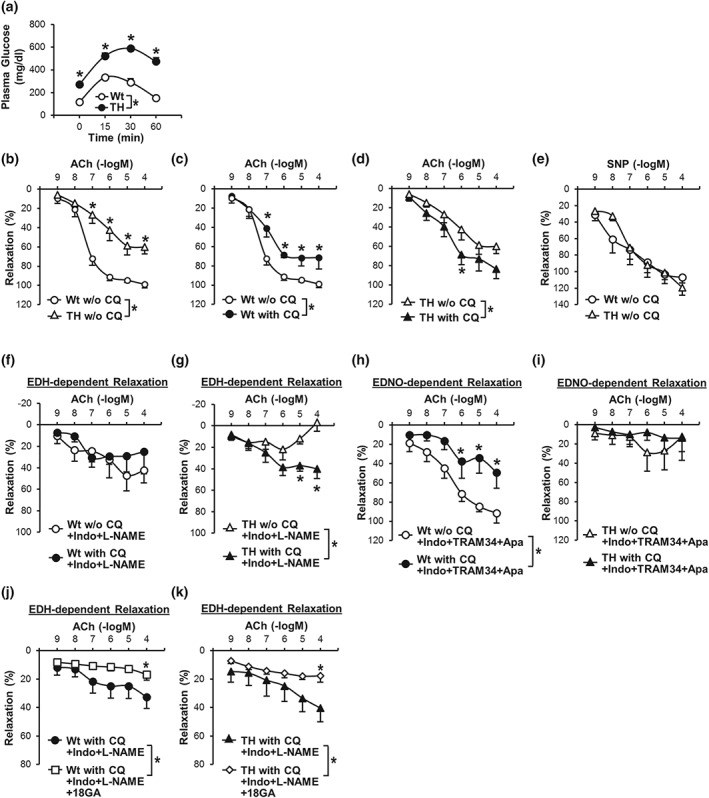Figure 3.

CQ enhances EDH‐dependent coronary vasodilation in diabetic mice. (a): Oral glucose tolerance test in Wt mice (n mice = 7) and TH mice (n mice = 7). *P < .05 compared to Wt mice. (b) EDR in CAs from Wt and TH mice without CQ treatment (w/o CQ). Wt w/o CQ, n mice = 13; TH w/o CQ, n mice = 12. Data are mean ± SE. *P < .05 compared to Wt w/o CQ. (c) Effect of CQ on EDR in CAs from Wt mice. Wt w/o CQ, n mice = 13; Wt with CQ, n mice = 9. Data are mean ± SE. *P < .05 compared to Wt w/o CQ. (d) Effect of CQ on EDR in CAs from TH mice. TH w/o CQ, n mice = 12; TH with CQ, n mice = 8. Data are mean ± SE. *P < .05 compared to TH w/o CQ. (e) SM‐dependent relaxation induced by SNP in CAs from Wt (n mice = 5) and TH mice (n mice = 5) in the absence of CQ treatment (w/o CQ). (f) EDH‐dependent relaxation in CAs isolated from Wt mice in the absence or presence of CQ. n mice = 7 in each group. (g) EDH‐dependent relaxation in CAs from TH mice in the absence or presence of CQ. n mice = 7 in each group. *P < .05 compared to w/o CQ. (h) EDNO‐dependent relaxation in CAs from Wt mice in the absence or presence of CQ. n mice = 6 in each group. *P < .05 versus w/o CQ. (i) EDNO‐dependent relaxation in CAs from TH mice in the absence or presence of CQ. n mice = 5 in each group. Indo and L‐NAME were used to inhibit PGI2 and NO in experiments shown in (f) and (g), while Indo, TRAM34, and apamin were used to inhibit PGI2 and EDH in experiments shown in (h) and (i). (j) EDH‐dependent relaxation in CAs isolated from Wt mice in the presence of CQ with vehicle (0.25% ethanol) or 18GA (a non‐specific Gap junction inhibitor, 50 μM). n mice = 8 in each group. (k) EDH‐dependent relaxation in CAs from TH mice in the presence of CQ with vehicle or 18GA. n mice = 8 in each group. *P < .05 versus w/o 18GA. Statistical comparison between dose–response curves were made by two‐way ANOVA with Bonferroni post hoc test
